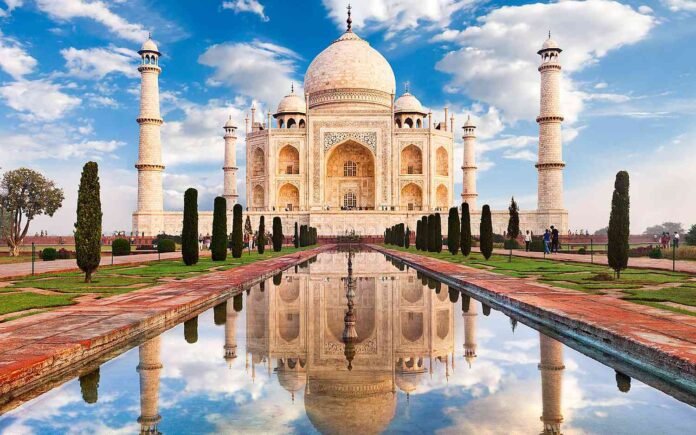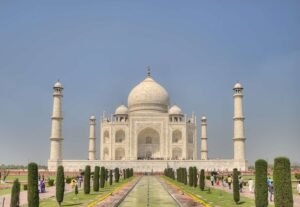The Timeless Beauty and Rich History of the Taj Mahal.
2 min read 2024-01-13, 01:00 AM IST
Summary of the content
The Taj Mahal, a symbol of enduring love and architectural brilliance, stands as a testament to the grandeur of Mughal architecture and the depth of human emotion. Located in Agra, India, this ivory-white marble masterpiece is a UNESCO World Heritage Site and one of the New Seven Wonders of the World. With its captivating beauty and rich historical significance, the Taj Mahal continues to enchant millions of visitors from around the globe.
ALSO READ| Fatehpur Sikri.
Historical Background
Commissioned in 1632 by the Mughal emperor Shah Jahan, the Taj Mahal was built as a mausoleum to honor the memory of his beloved wife Mumtaz Mahal, who died during childbirth. The construction involved the efforts of thousands of artisans, architects, and laborers over two decades, finally reaching completion in 1653. The Taj Mahal’s construction embodies the peak of Mughal architecture, incorporating elements from Persian, Indian, and Islamic styles.
ALSO READ| Humayun’s Tomb.
Architectural Marvel
- The Taj Mahal’s architectural magnificence is characterized by its symmetrical layout, intricate carvings, and meticulous detailing. The main mausoleum, standing on a marble platform, is surrounded by a beautiful charbagh (quadrilateral garden) with pathways, reflecting pools, and fountains. The central structure is crowned by a large white dome, flanked by four smaller domes, creating a harmonious and balanced aesthetic.
- The exterior of the Taj Mahal is adorned with elaborate calligraphy, floral patterns, and semi-precious stones inlaid into the marble – a technique known as pietra dura. This delicate craftsmanship showcases the skilled artistry of Mughal artisans. The play of light on the white marble throughout the day creates ever-changing nuances, from the soft hues of sunrise to the warm glow of sunset, adding to the monument’s ethereal beauty.
- Inscribed on the entrance gate are verses from the Quran, inviting visitors into the tranquil space that houses the tombs of Shah Jahan and Mumtaz Mahal. The tombs, beautifully carved and adorned with precious stones, are the focal point of the interior. The delicacy of the marble lattice screens (jali) allows natural light to filter into the chambers, creating a serene atmosphere within.
Symbolism and Romance
The Taj Mahal is not merely a physical structure, it is a symbol of enduring love and devotion. Shah Jahan’s commissioning of the mausoleum as a final resting place for Mumtaz Mahal reflects a deep and eternal love. The intricate detailing and thoughtful design elements are said to symbolize the celestial paradise described in Islamic tradition.
Legend has it that Shah Jahan intended to build a black marble mausoleum across the Yamuna River as his own final resting place, creating a mirror image of the Taj Mahal. However, due to political upheavals, he was unable to realize this vision. Instead, he was interred next to Mumtaz Mahal in the Taj Mahal itself, uniting the couple in eternity.
Conservation and Preservation
Over the centuries, the Taj Mahal has faced various challenges, including environmental pollution, natural disasters, and the effects of time. The white marble has been prone to yellowing due to air pollution, prompting conservation efforts to preserve its pristine appearance. Stringent measures, such as restricting vehicular traffic around the monument and controlling industrial emissions in the vicinity, have been implemented to mitigate environmental impact.
In recent years, restoration projects have been initiated to address structural issues and maintain the Taj Mahal’s integrity. These efforts aim not only to preserve the monument’s physical structure but also to ensure that future generations can experience its timeless beauty.
ALSO READ| Sunder Nursery.
Tourist Experience
The Taj Mahal attracts millions of visitors annually, both domestic and international, making it one of the most visited landmarks in the world. Tourists are drawn not only by its architectural splendor but also by the poignant love story that underlies its creation. The monument’s ethereal beauty, especially during sunrise and sunset, has led to it being hailed as a photographer’s paradise.
Visitors can explore the vast gardens, marvel at the intricate details, and immerse themselves in the historical and cultural significance of the Taj Mahal. The site also offers a museum that provides insights into the Mughal era, showcasing artifacts and exhibits related to the construction and history of the monument.
Conclusion
The Taj Mahal stands as an eternal tribute to love, artistic brilliance, and cultural heritage. Its enduring beauty and historical significance have made it a global icon, representing the rich tapestry of India’s past. As a masterpiece of Mughal architecture, the Taj Mahal continues to captivate the hearts and minds of those who have the privilege of experiencing its grandeur. In its silent elegance, the Taj Mahal reminds us of the timeless power of love and the enduring legacy of human creativity.


